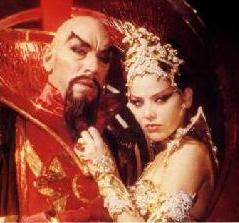
“According to legend, Genghis Khan lies buried somewhere beneath the dusty steppe of Northeastern Mongolia, entombed in a spot so secretive that anyone who made the mistake of encountering his funeral procession was executed on the spot.
Once he was below ground, his men brought in horses to trample evidence of his grave, and just to be absolutely sure he would never be found, they diverted a river to flow over their leader’s final resting place.”
I am no authority with regards one of the more well known Asian historical figure, and whatever “knowledge” I have of Genghis Khan is basically from Robert Shea’s (Shike – Last of the Zinja) portrayal of his grandson (?) Kublai Khan.
Shea’s Mongolian conqueror was depicted as someone respected by both his enemies as well as his ally, bright and highly articulate, but with a deadly ruthlessness in his quest of expanding his empire to the point of it being an obsession.
Before Shike came along, my image of the Mongolian conquerors (Kublai and Genghis) was that of Ming the Merciless from the campy science fiction series of Flash Gordon in the late 1970s.

It’s an image that’s particularly transfixing in the mind as to how Mongolians supposedly look like.
There is another television character which also play homage to this typical stereotyping, one I remember only by his oft quoted “Amazingg…”, most probably from the 1960’s Get Smart series about a bumbling spy.
The name of the character with the droopy, noodle moustache escapes me.
The modern interpretation of the great conqueror is far less stereotypical however as seen in Sergei Bodrov’s film Mongol (2007) where ironically, Japanese actor Asano Tadanobu played the lead figure.

Irony in that the land of the Rising Sun proved the most recalcitrant of annexations for Kublai with two failed attempts that “shattered the myth of Mongol invincibility throughout Asia” (The Mongol Conquerors), the second of which was depicted in Shea’s Shike in great, albeit purely fictional, detail.
The world’s history has been made that much richer from these strong, driven characters, but little has been paid to those whose lives were affected by the actions of these great men (and women).
This is exactly where the realm where fiction thrives.
Combining accepted facts with fiction, good writers are able to weave totally believable tales of characters living during such tumultuous times, and in so doing breathing some measure of reality and drama into dull, staid, historical facts.
Incidentally the first two para of this posting is from a Bernama news flash of students from the University of California’s (San Diego) Center for Interdisciplinary Science in Art, Architecture and Archaeology using advanced visualisation technologies to locate the tomb of the late Genghis.
Apparently researchers have tried in vain to locate the tomb’s site since 1990, so these students are raring for another go at it, and this time, technology is hoped to provide the breakthrough.
Dr. Albert Yu-Min Lin, an affiliated researcher of the Center, tells us why: “But as great a man he was, there are few clues and no factual evidence about Genghis Khan’s burial, which is why we need to start using technology to solve this mystery.”
If only I had foreseen all those years ago historians having this much fun.
No comments:
Post a Comment